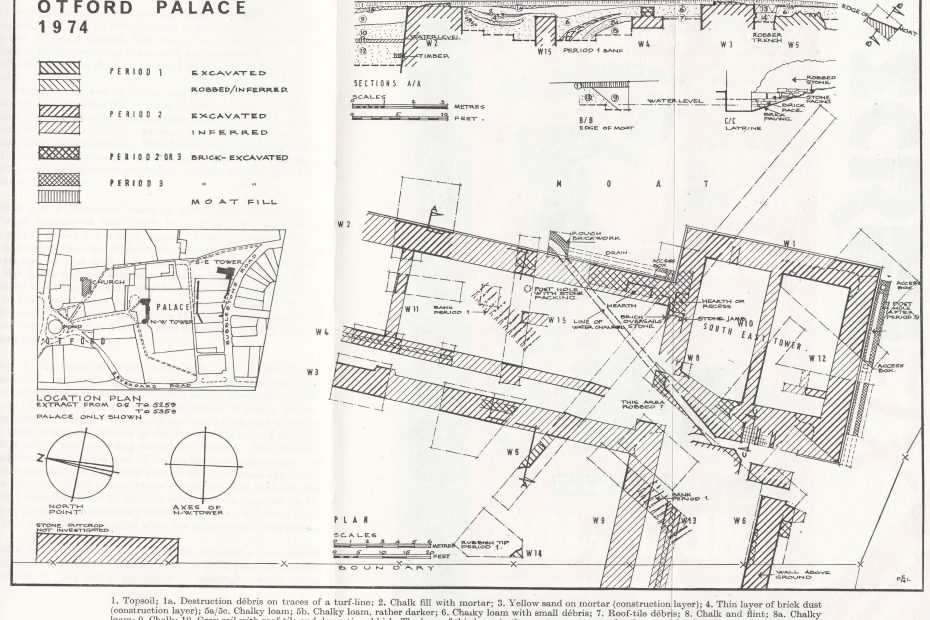Planning consent for the construction of four detached houses had been given on a large plot on the north side of Bubblestone Road, although it was certain that it occupied the south-east corner of Otford Palace. In the few week-ends before construction work began the Otford and District Archaeological Group dug four small trenches on the site predictably revealing some Tudor masonry. The site was then handed back to the builder the next day (Monday 11th March) who immediately began removing trees ahead of ripping out all the masonry. However, on the Sunday evening before (10th March) Joy Saynor, local historian from nearby Shoreham, telephoned Brian Philp, Director of the Kent Archaeological Rescue Unit, because she was rightly very concerned at the pending destruction of a large part of a major monument.
Brian Philp arrived at the site at 8.30am the next day and immediately negotiated with the builder and arranged a 24-hour stay. He contacted the DOE (Ancient Monuments section) which led to site meetings and an acceptance by the Unit of an invitation from the DOE to carry out a five-week major rescue excavation, which started on 24th March 1974. The agreement was that at the end of this period the site would either be bought from the builder, or returned to him and then be destroyed as intended. The DOE agreed to provide limited funds for the excavation and recording.
The Kent Unit immediately launched a large-scale operation aimed at totally excavating the threatened area. It moved its fulltime team up from Dover and its part-time team from Bromley and West Kent and also invited local groups through the Council for Kentish Archaeology. In all, 98 archaeologists took part in the excavation.
There followed 35 days of non-stop rescue-excavation, which produced spectacular results. Massive masonry revealed two large ranges of rooms, joining a substantial corner tower some 13m square. This contained an elaborate garderobe complex fed by flowing water through drains and culverts. Numerous artefacts were recovered including from a wide Tudor moat. Beneath were parts of an earlier structure of 14th century date part of the original manor-house, complete with its own garderobe shafts. This had its own moat which had been filled in during the construction of the Tudor Place. An even earlier moat was also found, relating to an earlier structure beyond the site.
With such spectacular results it was clear that this major monument, of international importance, should not be destroyed. Just before the five-week deadline the Unit organised an open-day giving the public the only chance to see the discoveries ahead of possible destruction. Nearly 2,500 members of the public, from all over Kent and South-East London, were given guided tours. With on-site encouragement many wrote helpful letters of protest and the Unit appealed to both the House of Commons and the House of Lords for support. Here, Viscount Monckton of Brenchley directly approached the Minister. The Unit also approached the Sevenoaks District Council (formerly the Sevenoaks Rural District Council).
Understandably, there was no immediate response. The five-week period lapsed and continued access to the site was then denied. But on 7th May 1974, the full Sevenoaks District Council met and unanimously agreed to purchase the site! The Unit carried out final recording and arranged several school visits. It then covered the masonry with plastic sheeting and reinstated the whole area, which it then grass-seeded. The DOE stated that it was the best example of rapid excavation and preservation over the previous ten years. The whole project was very fully published in Philp (1984).
Taken from How Otford Palace Was Saved, by Richard Ansell. In Philp B, et al ((2020) Rescue Excavations in West Kent, Kent Archaeological Rescue Unit, Dover. ISBN 0-947 831 33 9.
Philp B, 1984, Excavations in the Darent Valley, Kent. Dover: Kent Archaeological Rescue Unit, Dover. ISBN 0-9502129-7-0.
